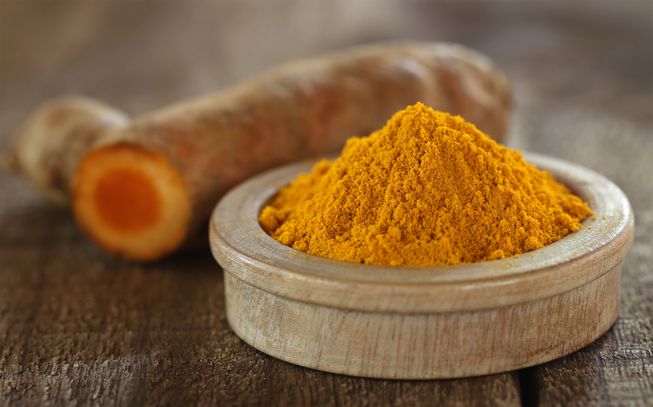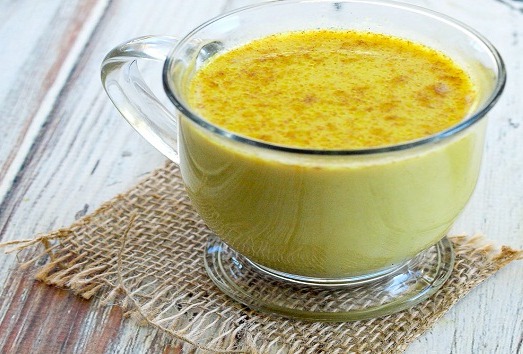
Let’s continue our new series with what many consider to be the most powerful spice available in both preventing and treating disease. It also happens to be one of the most studied spices with over 10,000 peer-reviewed articles published!
Turmeric has long been used in both cooking and dying. It has also played an important role historically in traditional Eastern cultures and Ayurvedic medicine.
 Turmeric comes from the Curcuma longa plant and is native to India and other South East Asian countries.
Turmeric comes from the Curcuma longa plant and is native to India and other South East Asian countries.
The root (rhizome) is harvested and used either fresh or it is dried and then ground into the distinctive yellow powder you’re probably familiar with.
If you’ve ever seen the fresh root you must have noticed how similar it looks to ginger. Well this is because they are actually in the same family of plants. You can think of them as cousins, which also might explain why many of their health benefits overlap.
Curcumin
There are several chemical compounds found in turmeric known as curcuminoids. Of these curcuminoids, the one that has been studied the most is curcumin.
Interestingly, curcumin makes up only about 3% of turmeric in weight. The remaining weight of turmeric contains carbohydrate, protein, vitamins, minerals, and essential oils.
The oils in turmeric have also shown beneficial properties. And actually research has supported this fact by showing that turmeric & turmeric oil, absent from curcumin, still has the ability to boost immunity, lower inflammation, support digestion, and more.
To learn more about the differences between turmeric and curcumin, along with all things related to turmeric, check out the Turmeric For Health website. Keep in mind that the benefits of turmeric oils only come from fresh turmeric.
What Does The Research Show
Many of the studies on turmeric/curcumin suggest that when compared to conventional medicine, turmeric benefits equal and sometimes surpass that of many pharmaceutical medications. Talk about food as medicine!
Let’s take a look at some of the more well established benefits of turmeric.
- Inflammation: Inflammation is a root cause of many chronic diseases. Turmeric’s powerful anti-inflammatory benefits can offer a protective effect.
- Immune Support: Both curcumin and the whole plant of turmeric have shown the ability to support immunity through its anti-inflammatory and antioxidant properties.
- Pain Management: Studies have shown promising results for both turmeric and curcumin in managing the pain and inflammation associated with arthritis.
- Heart Health: Both curcumin and turmeric have been shown to protect the heart by both improving endothelial function and reducing inflammation and free-radical damage.
- Brain Health: Curcumin has been studied for it’s ability to boost mood and act as an anti-depressant. It may also boost cognitive function thanks to its ability to boost brain-derived neurotrophic factor (BDNF). Because turmeric can cross the blood-brain barrier and lower inflammation in the brain it may also play a role in the prevention of Alzheimer’s (another Alzheimer’s review).
- Gut Health: The anti-inflammatory and anti-microbial properties of turmeric can also be used to soothe and support the gut.
- Cancer: Turmeric and curcumin have been studied extensively for their role in both the treatment and prevention of various cancers. (read more here, here, and here)
Turmeric Uses
In order to take advantage of all the benefits of turmeric, it’s important to include both fresh and dried. Let’s take a look at some of the easiest ways you can start adding more turmeric to your diet.

Internal
- Probably the easiest way you can start adding more turmeric is to add a pinch of turmeric powder to your cooking oil before cooking — veggies, eggs, rice, lentils, etc.
- It is the main ingredient in curry; Veggie Curry, Homemade Curry Powder
- You can add it fresh or dried to your Smoothies.
- Golden Turmeric Milk — Not only do you get the benefit of turmeric in this drink but also that of coconut oil, ginger, and cinnamon.
- Turmeric Broth — I include fresh turmeric root in my broth recipe but you could easily mix in another 1/2-1 tsp powdered turmeric directly into your broth before drinking it
- Roasted Chickpeas — Mix turmeric, ginger, cinnamon, cloves, cumin, and black pepper with olive oil and toss with chickpeas. Roast at 350°F until crispy (about 20 minutes).
- Other yummy recipes with turmeric to try — Moroccan Chicken, Fesenjan, Harira, Moroccan Chickpea and Veggie Soup
To get more inspiration on using turmeric in your cooking, lean on the cultures who have long used it in their cuisines — Indian, Iranian, Turkish, Moroccan, Thai, Vietnamese, & Cambodian.
External
There are also some external uses for turmeric, taking advantage of its anti-inflammatory and antioxidant properties.
- Teeth Whitening (this was a surprising benefit to me)
- You can use turmeric topically in a poultice or lotion to soothe inflammation and pain.
- Combined with aloe it can also be used to calm itchy or burned skin.
Keep in mind that turmeric will stain and when used topically it will likely leave a yellow hue until washed off.
Absorption
The bioavailability of turmeric powder is actually quite low. This means that most of the turmeric ingested is not digested by the intestines. There are several ways you can improve its availability.
- Combine with piperine (from black pepper) to increase it’s availability by 2000; just a pinch will do the trick.
- Combine with fats or oils.
- Fresh turmeric rhizome is better absorbed than dried because it still contains it’s volatile oils.
Interesting fact…..curry includes turmeric and black pepper (along with other spices) and always starts in a base of cooking oil. Ancient wisdom at play!
Dosing & Supplementation
Okay, the big question is how much should you be aiming for, right? Well, the easy answer is to just start using it more in your cooking and see if you can make it a regular part of your diet.
- 1 Tbsp of powdered turmeric ~136 mg curcumin
- 2 inch piece of fresh turmeric root will yield ~1 Tbsp grated, which provides ~125 mg curcumin
For general healthy living and disease prevention it is recommended to consume 1 to 3 grams of turmeric each day; this is between 1/2 – 1 1/2 tsp of dried turmeric (not very much, really).
Research has shown that turmeric is safe up to 12 grams per day; that’s a lot of turmeric! Be mindful though that for some folks higher levels may cause stomach upset.
If you are incorporating turmeric into your diet for curative or treatment purposes then the dosing guidelines will be much higher. Some studies have used 8-10 grams per day but only for a certain stretch of time. If you wish to use turmeric in this way, definitely consult a provider first to make sure you’re using a safe and appropriate amount.
Add More Turmeric!
Not only does turmeric add a beautiful color to your food, and earthy flavor, it also imparts time tested whole body health benefits. This may very well be why countries, like India, who traditionally use turmeric in much of their cuisine have lower than average rates of cancer and other chronic diseases.
The best part is you don’t have to add a supplement to get the health benefits. Simply start using it more in your cooking and reap the rewards!
Make it a goal to get ~1 tsp of fresh or dried turmeric in your diet every day.